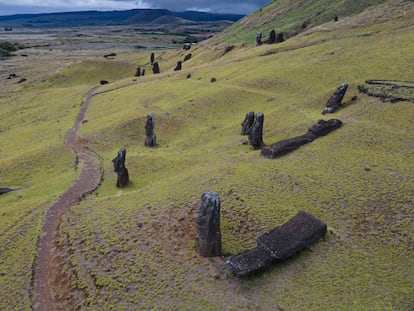A trip to the prison on Easter Island: ‘It’s paradise’
EL PAÍS visited the Indigenous territory’s penitentiary center, located in one of the most isolated corners of the planet
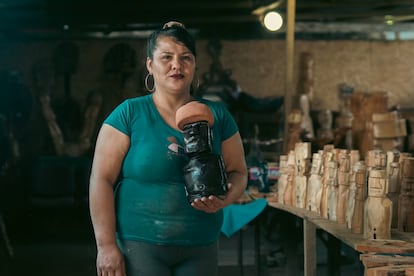

In town, the Rapa Nui people say that it’s a nursery school, made for adults. A hotel. A pleasant place to stay. Anything, except a prison. The instructions to access the penitentiary on Easter Island offer some clues as to what the locals are referring to. “Follow the palm tree path. When you get to the soccer field, turn left.”
On one of the most isolated pieces of inhabited land on the planet, there are a handful of prisoners serving time. There are no guard booths; there are no uniformed officers carrying weapons. Nor is there a clearly-defined perimeter (the Pacific Ocean fulfills that function). Instead, there’s a crafts workshop, where prisoners have access to chainsaws and chisels, so that they can sculpt wooden moai figures.
Once sanded and varnished, the statues are neatly displayed in a storefront. Tourists come by on most days of the week to window-shop or buy souvenirs. The inmates attend to the clientele and offer them discounts. With part of their earnings, they order a good fresh tuna, or ribs for the grill.
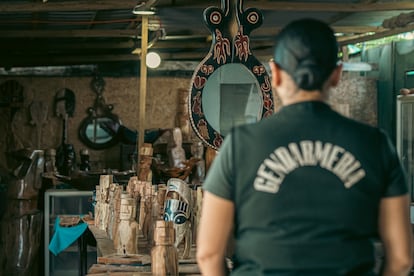
Ana Miraji, 40, is one of the 12 people deprived of their liberty. A year ago, there were six, but the increase in drug-trafficking has altered the prison population. On the island, you no longer only see cannabis: nowadays, ecstasy and cocaine are also circulating. Miraji was arrested for selling the latter.
The Easter Island court ordered the police to arrest her, but she ended up being caught 2,200 miles away from the island, in the Chilean region of Valparaíso. This meant that she was sent to the port city’s jail, where she served the first year-and-a-half of her five-year sentence. “It’s hell there,” she laments. When EL PAÍS asks her what the main differences between the two correctional centers are, she replies: “[On the mainland], you can’t have a refrigerator, perfumes. You can hardly make any money. They don’t let you come and go or eat what you want,” she explains. “Here, it’s paradise,” she adds.

With the money Miraji earns from her plaster sculptures (she’s been an artisan since she was 17 years old) she buys whatever she wants to eat, such as ribs or shrimp. With the daily call that she’s allowed, she contacts a taxi driver friend, who picks up her groceries and brings them to her when deliveries are allowed: Monday, Wednesday and Friday. Tuesdays and Thursdays, meanwhile, are family visiting days, when tourists aren’t received (about 250 come each month).
Another big difference between the Easter Island prison and those on the Chilean mainland is how the inmates treat each other. In Valparaíso, Miraji recalls how, when she was locked up, friendship didn’t exist. She had to fight, hit and get hit to earn respect. Now, she explains — while looking towards the interior patio — the atmosphere is calm and good treatment reigns. And they all know each other. On an island of about 6,000 inhabitants, they’ve all grown up together.
Do you have any family here? “Everyone is my family,” she laughs. “He’s my cousin, that’s another cousin, there’s a guy over there…” the woman notes, as she points out different inmates who are circulating.
Chile’s Gendarmerie — the national prison service — assumed control of the 10,000-square-foot penitentiary in 2005. Previously, the Carabineros (national law enforcement officers) were responsible. During that period, the prisoners could enter and leave the grounds without major problems, which cemented a series of myths that the Rapa Nui people have, over time, managed to discard. Many thought that the prisoners were going out to the sea to fish, or that they had access to cellphones.
Officer Ariel Morales took over a year ago as director of the Rapa Nui penitentiary unit. There are 23 officials at the facility in total, four of them being from the Rapa Nui tribe. Morales came to the island from the prison in Valparaíso. And, prior to that, he worked in Colina 1, a large jail in the capital of Santiago. The change in his work environment has been “drastic.”
“Here, everything follows the cultural norms — that’s where everything starts,” he explains.
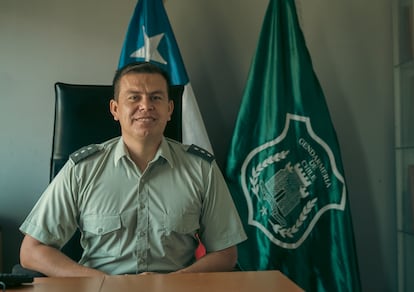
In addition to the importance of fish in the local diet, Officer Morales highlights that the Rapa Nui have “the notion of freedom very deeply rooted” in their culture. “When you realize that space is limited on the island (it has an area of 60 square miles), you’d think that people would feel confined. But not them. As a result, the idea of restricting movement obviously shocks them much more than other people,” he points out.
He also feels that there’s a lack of criminality on the island, that those who are incarcerated don’t fit the same profile as inmates from the mainland. “Here, we deal with soft power a lot. To be able to contain them, we frequently talk to them [and] we respond to their requests,” he describes.
The subject of the restriction of freedom on Easter Island goes beyond the prison walls. The president of the Council of Elders for the Rapa Nui, Carlos Edmunds, recalls the time at the end of the 19th century and the beginning of the 20th when the Indigenous territory fell under Chilean sovereignty (1888) and was given as a concession to the British company Williamson & Balfour, known as the Easter Island Exploitation Company. The firm transformed Rapa Nui into a sheep ranch, “forcing the population to live only in the Hanga Roa [district],” as acknowledged in the historical Truth and New Deal Commission, implemented in 2003 by the socialist administration of President Ricardo Lagos. Following the end of the concession, Edmunds says, the Rapa Nui were locked up on the island, until Chile gave them citizenship in 1966. “We were prisoners, we couldn’t leave,” he remembers, until civil administration finally arrived, with judges, police officers and a governor.

The prison, which was built in 1920, is far from being luxurious. Still, it has its amenities. The rooms are designed for two or three inmates. Each one has a flat-screen TV with cable, a newly remodeled private bathroom, as well as kitchen utensils, such as a kettle or pots. On one side of the communal patio, there’s a garden with tomatoes, chives, sweet potatoes and other vegetables.
It’s noon when EL PAÍS visits. Catholic mass has just been held under the open sky, just like on every first Friday of the month. Saturday is the Evangelicals’ turn. Those deprived of their liberty — 10 men and two women — chat in small groups, next to the grill and the foosball table.
The crowing of a rooster disrupts the serenity that inhabits the prison. The guard asks how the egg hatching is going. The inmates recently set up a chicken coop, which they proudly display on the other side of the building. Their facility is located at the edge of the land, protected by a low fence running between different species of trees, with bright green hills in the background. The horizon is beautiful, but you can’t see the sea. And that, to the islanders, weighs on them.
Construction worker Eduardo Hermosilla, 37, always ended his workday by swimming in the deep waters of the Pacific. He’s currently serving an 11-month sentence for domestic violence — he attacked his brother-in-law — and has two more months to go before being released. He’s a sweet and resilient man. He says that, no matter how nice everything looks, “it’s not a suitable place for anyone.”
“Living with schedules that aren’t yours, spending the holidays locked up… I have six children. And that’s six Christmases you miss, six birthdays. It’s hard. I would be lying if I said I was happy, comfortable,” he sighs, his voice breaking. In any case, he appreciates what he has learned, as well as the camaraderie.
Before joining the workshop, Hermosilla had never done crafts. Today, he teaches others how to make works of art out of wood. Whatever he earns from selling to tourists, he sends to his family.
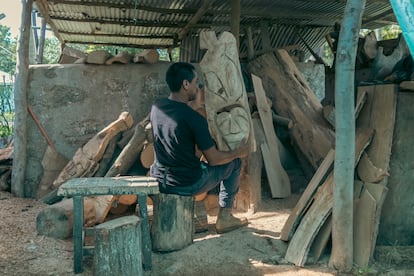
Some prisoners have escaped, but they return after two hours. Six months ago, surveillance cameras were installed. But even without them, police officers could quickly find the fugitives. And it’s not simply that there’s nowhere to escape to: if they managed to flee the island completely and reach the mainland, they know that they could end up somewhere else. Somewhere much worse: in a real prison.
Sign up for our weekly newsletter to get more English-language news coverage from EL PAÍS USA Edition
Tu suscripción se está usando en otro dispositivo
¿Quieres añadir otro usuario a tu suscripción?
Si continúas leyendo en este dispositivo, no se podrá leer en el otro.
FlechaTu suscripción se está usando en otro dispositivo y solo puedes acceder a EL PAÍS desde un dispositivo a la vez.
Si quieres compartir tu cuenta, cambia tu suscripción a la modalidad Premium, así podrás añadir otro usuario. Cada uno accederá con su propia cuenta de email, lo que os permitirá personalizar vuestra experiencia en EL PAÍS.
¿Tienes una suscripción de empresa? Accede aquí para contratar más cuentas.
En el caso de no saber quién está usando tu cuenta, te recomendamos cambiar tu contraseña aquí.
Si decides continuar compartiendo tu cuenta, este mensaje se mostrará en tu dispositivo y en el de la otra persona que está usando tu cuenta de forma indefinida, afectando a tu experiencia de lectura. Puedes consultar aquí los términos y condiciones de la suscripción digital.
More information
Archived In
Últimas noticias
Most viewed
- Sinaloa Cartel war is taking its toll on Los Chapitos
- Oona Chaplin: ‘I told James Cameron that I was living in a treehouse and starting a permaculture project with a friend’
- Reinhard Genzel, Nobel laureate in physics: ‘One-minute videos will never give you the truth’
- Why the price of coffee has skyrocketed: from Brazilian plantations to specialty coffee houses
- Silver prices are going crazy: This is what’s fueling the rally
